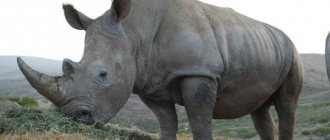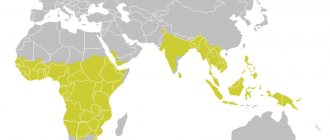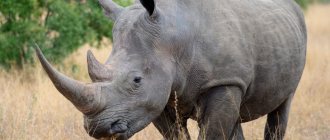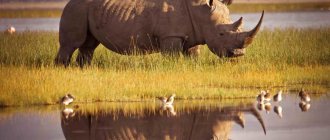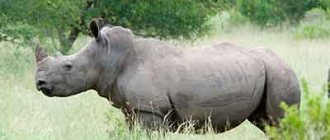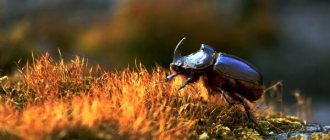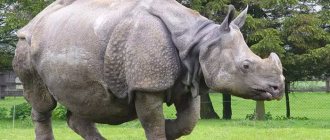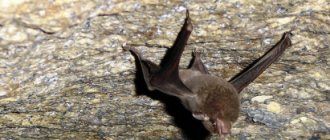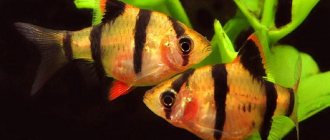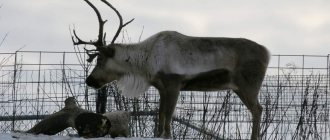- Wild animals
- >>
- Mammals
The Sumatran rhinoceros is an ancient animal of enormous size. Today it is not so easy to find it in its natural habitat, since the species is almost on the verge of complete extinction. It is very difficult for zoologists to determine the exact number, since animals lead a hidden, solitary lifestyle and their habitat is very wide. This species is considered the smallest among all existing on earth, as well as the only one in the world who has two horns.
Appearance
The height of the animal can vary from 112 to 145 cm. The body length is on average 230-250 cm. The weight of a rhinoceros can range from 800 kg to two tons. The hair of animals consists of brown hairs. The rhinoceros has the most hair on its tail. Sumatran rhinoceros skin – no more than 16 mm. There are small folds on the neck and belly. The length of the animal's front horn usually does not exceed 25 cm. They are usually black. They also have a small, dark-colored rear horn.
Sexual dimorphism is expressed by body structure. So, the male is much larger than the female. In addition, females do not have such long horns.
Genus of Sumatran rhinoceroses (Dicerorhinus)
Interesting facts about rhinoceroses
- Only in 1513 did the inhabitants of Europe learn about the existence of a “strange beast.” It was handed over to the Portuguese king Manuel I by the Indian Raja of Cambay. At first the rhinoceros was displayed to the crowd, and then they decided to send it to the Pope. The animal could not withstand the sea voyage, it went berserk, crashed through the side of the ship and drowned in the sea.
- Over the past 15 years, several species of animals have disappeared completely on Earth. Among them is a subspecies of the black rhinoceros - the western black rhinoceros (lat. Diceros bicornis longipes).
- The large rhinoceros Merka (lat. Diceros merki) lived in Eurasian forests in the Quaternary period of the Cenozoic era, another rhinoceros - elasmotherium (lat. Elasmotherium) lived until the Holocene, and relatively recently (8-14 thousand years ago) the woolly rhinoceros (lat. Coelodonta antiquitatis). The largest representative of rhinoceroses in the history of the Earth was Indricotherium (lat. Indricotherium), who lived 20-30 million years ago. Its height was 8 meters, and it weighed up to 20 tons.
- The skeleton of a woolly rhinoceros (lat. Coelodonta antiquitatis), collected from the bones of various individuals found in Siberia, can be seen in the paleontological museum of Tomsk State University. The length of its larger horn is 120 cm, the smaller one is 50 cm, the height of the skeleton is 160 cm. Scientists have established that the horns of the woolly rhinoceros grew throughout its life.
- The word “rhinoceros” is found not only in the name of an equid animal. There is also the rhinoceros beetle, hornbill, rhinoceros viper, rhinoceros cockroach, rhinoceros fish, rhinoceros iguana. They all have horns, making them look like a large, beautiful mammal.
- The World Wildlife Fund (WWF) established Rhino Day in 2010, which is celebrated on September 22.
Extinct woolly rhinoceros. Photo credit: Honymand, CC BY-SA 4.0
Where does it live?
These animals live in Sumatra and the Malay Peninsula. Some experts also note that Burma also has a small population. Sumatran rhinoceroses can be found in the tropical forest, near swamps. They also live in mountain forests. In general, animals love areas that are well supplied with moisture.
Reasons for the extinction of Javan rhinoceroses
The last Javan rhinoceros was captured in Vietnam in 2010. The almost complete disappearance of these large mammals from the face of the Earth was caused by factors such as poaching, loss of habitat, disease, and inbreeding (crossing of closely related forms within the same population). Farmers destroyed them as agricultural pests, and trophy hunters hunted them for their horns, which were valued in Asian medicine. In addition, these animals are extremely vulnerable to natural disasters.
Today, the population in Ujung Kulon National Park represents the only hope for survival of the species. If we lose the population in Java, the entire species will disappear.
Lifestyle
This species of rhinoceros is accustomed to a solitary lifestyle. Only during the period of reproduction and raising offspring do females and males live together. Typically, each male owns a territory of 50 km2, and the female’s “house” is 5 times smaller. Females are almost always far from each other, but for males everything is different. They mark their territory using excrement. Sometimes animals mark out their habitat by scraping the soil. Sumatran rhinoceroses are especially active in the evening. When the rainy season comes, they prefer to go high into the mountains, but with the onset of cold, the animals have to go down.
Rhinoceroses love to spend time wallowing in the mud. When there is no suitable hole, they use their horns to expand it. This pastime helps maintain thermal balance in the body and protects against insect bites. They usually spend 2 hours a day in the mud, but in captivity this time is reduced to 40-45 minutes. Sometimes rhinoceroses can replace mud baths with swimming.
Individuals always create trails in the territory of their “home”. There are two types of trails: the main ones, which act as bridges between important places, such as salt licks, and those that help to easily reach areas with the necessary food. These trails may be located on the territory of reservoirs, the depth of which can reach one and a half meters.
Lifestyle, social behavior and reproduction of Javan rhinoceroses
These animals lead a solitary lifestyle, with the exception of the mating season. Sometimes young animals can form pairs or small groups for a while.
Males have individual territories (12-20 km2), which only slightly overlap with the territories of other males. There is no information about whether fights occur between males if a neighbor encroaches on someone else’s territory. What is known is that males mark the boundaries of their territory with piles of dung, urine and scratches on trees and the ground.
Individual home ranges of females are smaller (3-14 km2) and significantly overlap each other.
Javan rhinoceroses spend most of their time wallowing in mud pits. Animals can use temporary puddles and puddles, which they deepen with their feet and horns. Access to mud pits is necessary for thermoregulation, skin health and getting rid of ectoparasites (parasites that live on the surface of the host) and bloodsucking insects.
Nutrition
Rhinoceroses are herbivores. Their diet is very diverse and includes hundreds of plant species. They feed mainly on leaves, young shoots and twigs. Sometimes they eat fallen fruits. An adult rhinoceros requires about 50 kg of food per day.
Sounds
Javan rhinoceroses can make sounds similar to grunting, squealing, snorting, and snoring. However, they are much less talkative than their Sumatran counterparts. Smells play a much larger role in communication.
What does it eat?
Sumatran rhinoceroses prefer to graze in the evening, namely before it begins to get dark. Every day they need to eat about half a hundredweight of food. Salt is vital for these mammals, which is why they are frequent visitors to salt licks. They eat the leaves and fruits of trees - representatives of the Rubiaceae, Euphorbiaceae, and Melastomaceae families. This food contains a lot of fiber and protein.
Rhinos like small seedlings best. They pile their full weight on a bush or tree and mercilessly eat the leaves. Most of the plant species that rhinos need can be found in small quantities in any given area, forcing the animals to constantly change their diet and feeding areas.
Rhinoceros: description, structure, characteristics. What does a rhinoceros look like?
The Latin name of the rhinoceros - Rhinocerotidae, is essentially identical to ours, since “Rhino” means “nose”, and “ceros” is a horn, resulting in “rhinoceros”, this name very aptly characterizes this animal, because the large horn on the nose, growing from The nasal bone is an integral attribute of all decent rhinoceroses (however, not decent ones either).
And also the rhinoceros, the largest land mammal after the elephant - the length of the rhinoceros is from 2 to 5 meters, with a height of 1-3 meters and a weight of 1 to 3.6 tons.
The colors of rhinoceroses depend on their species; in fact, at first glance, it seems that the names of rhinoceros species actually come from their colors: white rhinoceros, black rhinoceros. But here not everything is so obvious and unambiguous, the fact is that the real skin color of both white and black rhinoceros is the same - gray-brown, but due to the fact that these rhinoceroses like to wallow in the ground of different colors, which colors them different colors, and so did their names.
The head of a rhinoceros is long and narrow, with a steeply sloping forehead. Between the nasal bones and the forehead there is a concavity, somewhat similar to a saddle. The small eyes of a rhinoceros with brown or black pupils and their size look very contrasting against the background of their large head. As we already mentioned at the beginning, rhinoceroses’ eyesight is not important; they are only able to see moving objects from a distance of no more than 30 meters. In addition, the fact that their eyes are located on the sides does not give them the opportunity to properly examine this or that object; they see it first with one eye, then with the other.
But rhinoceroses’ sense of smell, on the contrary, is well developed, and it is on this that they rely most. Interestingly, the volume of the nasal cavity in rhinoceroses is larger than the volume of their brain. The hearing of these giants is also well developed; the ears of rhinoceroses are like tubes that constantly rotate, picking up even faint sounds.
The lips of rhinoceroses are straight and awkward, with the exception of the Indian and black rhinoceroses, which have a movable lower lip. Also, all rhinoceroses have 7 molars in their dental system, which wear out greatly with age; in addition to teeth, Asian rhinoceroses have incisors, which are absent in African rhinoceroses.
All rhinoceroses have thick skin, which is almost completely devoid of hair. The exception here is the modern Sumatran rhinoceros, whose skin is still covered with brown hair, and the woolly rhinoceros that once lived in our latitudes, which, together with the same woolly mammoth, unfortunately, has not survived to this day.
The legs of a rhinoceros are heavy and massive, each foot has three hooves, as a result of which it is very easy to recognize by the rhinoceros's tracks where these giants walked.
Reproduction
In females, puberty occurs at 6 years old, and in males only at 10. Pregnancy in rhinoceroses is long and lasts as much as 65 weeks. When born, the cubs weigh only 40-50 kg, the mother feeds them as much as she carries them. The cubs live with the female until they reach two or three years of age. In the wild, females produce offspring once every 4-5 years.
Sumatran rhinoceroses have rather atypical courtship behavior. Males often hit females directly in the face and urinate on them. Young males sometimes kill females, but they can avoid death in the wild. Despite this aggressive behavior, males court the female when she comes into heat. This period lasts a day, but repeats every 20-25 days.
Rhinoceroses and elephants are not mortal enemies
The myth of hatred between these two species of animals dates back to ancient times. In 1515, King Manuel I of Portugal decided to test this myth. He got a female Indian rhinoceros named Ganda, who found a home in the royal menagerie, away from the elephants. But one day, the king arranged a fight between the animals, with the participation of the royal family and guests. The youngest elephant in the king's menagerie was brought into the arena from the stables. The tapestries hiding the rhinoceros were left open. The official observer writes that the rhinoceros appeared in a rage and immediately attacked his enemy so forcefully that the young elephant broke free of his chains, began to scream loudly and overcame the thick barrier with iron bars. This incident certainly helped support this myth.
Number and Red Book
Today there are only 275 individuals left in the world . There are 6 populations of this mammal in the world, 4 of which are located in Sumatra. That is why the Sumatran rhinoceros is listed in the International Red Book. Back in 2011, the future of the population was unclear, and now the species is almost on the verge of extinction. This happens because poachers kill rhinoceroses every day and it is difficult to protect the population due to its scattered nature throughout its habitat. This also happens due to hunting for the horns and bones of the animal. They are actively used by the population of Sumatra to treat diarrhea and even tuberculosis. Their horns are also needed to create all sorts of elixirs that prolong life. The task is complicated by the fact that these animals are reluctant to breed in captivity.
Origin of the species and description
Photo: Sumatran rhinoceros
The Sumatran rhinoceros is a chordate animal. It is a representative of the class of mammals, the order of equids, the family of Rhinoceros, the genus and species of the Sumatran rhinoceros. It is considered a very ancient animal. According to scientists, it is the representatives of this species that are the descendants of the woolly rhinoceros, which became extinct about 10 million years ago and inhabited all of Eurasia.
Video: Sumatran rhinoceros
The species this animal belongs to is called Dicerorhinus. Translated from Greek, the name means two horns. The Sumatran rhinoceros diverged from other equids during the early Eocene. The study of the DNA of this animal suggested that the ancestors of the animal separated from the distant ancestors of the equine family approximately 50 million years ago.
Interesting fact: The oldest fossils that belong to representatives of this species indicate that the animals existed 17-24 million years ago. Scientists did not come to a consensus and were unable to reconstruct a complete picture of the evolution of the rhinoceros.
In this regard, there are several theories of animal evolution. The first states that they are closely related to African species of rhinoceroses, from which they inherited a double horn. The second states that they are related to Indian species, which is confirmed by the intersection of the species’ habitat. The third theory does not confirm any of the previous ones and is based on the results of genetic testing. It indicates that all of the above types are different and are in no way related to each other.
Subsequently, scientists discovered a close family relationship between Sumatran rhinoceroses and woolly ones. They appeared during the Upper Pleistocene and became completely extinct about 10 million years ago.
Sumatran rhino conservation
All rhino problems are solved by placing rhinos in breeding enclosures. Currently, Sumatran rhinoceroses are bred and kept at the Cincinnati Zoo. This institution is actively involved in a program aimed at preserving endangered species. Baby Andalas was born there relatively recently. There are also Sumatran rhinoceroses in the London Zoo, where the animals are provided with all the necessary conditions.
Rhinoceroses are perhaps the largest pets
No matter what the Japanese bred there, domesticated rhinoceroses are no longer a novelty. There are not many cases when these wild dangerous animals lived next to humans, but they do exist.
For example, in 2007, 71-year-old Anne Whitetall from Zimbabwe became the second mother to a black rhinoceros calf. The baby's mother was killed by poachers, and Ann's friend, photographer David Hume, found him in the bushes.
Another incident occurred in South Africa in 1960. A local veterinarian rescued a baby rhino from a flood and took him home. The baby grew up friendly and playful, and protected the house no worse than any watchdog.
